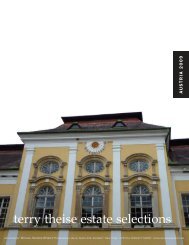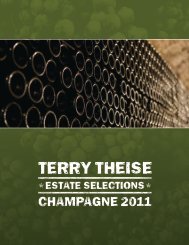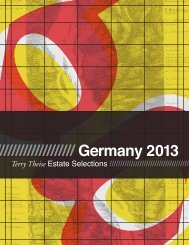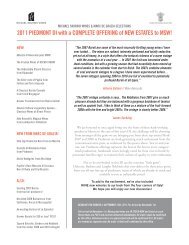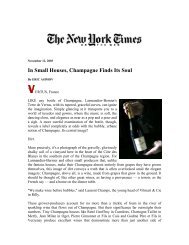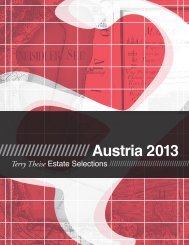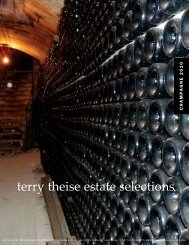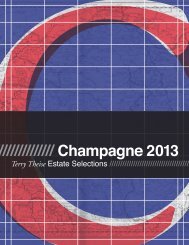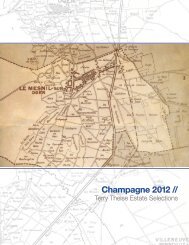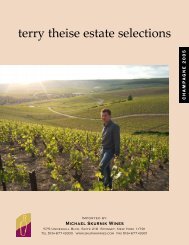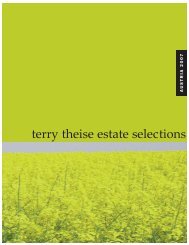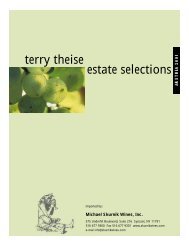German Catalog 2006 USE THIS ONE.qxp - Michael Skurnik Wines
German Catalog 2006 USE THIS ONE.qxp - Michael Skurnik Wines
German Catalog 2006 USE THIS ONE.qxp - Michael Skurnik Wines
You also want an ePaper? Increase the reach of your titles
YUMPU automatically turns print PDFs into web optimized ePapers that Google loves.
MOSEL WINES<br />
82<br />
carl loewen<br />
mosel • leiwen<br />
Here at Theise selections we like to say We ain’t no spinning cone zone! Hey, come to our office and<br />
you’ll hear us say it all the time, at the water cooler, in the company kitchen, in the parking lot.<br />
We hate spinning cones and everything they imply. Instead we like growers like Carl Loewen<br />
who say lovely true things like “A good wine is always made first in the mind.” Here are some other<br />
things he says.<br />
“In the modern world of winemakers there are hitherto unimagined possibilities to form<br />
the tastes of wines. The grape-breeders send us ever-new varieties, in my region there are people<br />
using barriques, using the most current techniques to concentrate natural musts; special cultured<br />
yeasts aim to form the characters of wines, and special enzymes to form bouquets.<br />
Is this the brave new wine-world?<br />
I have a different philosophy. Wine is a product of<br />
nature, the badge of its origin. And anyone who thinks<br />
this way views terroir as the defining important point.”<br />
Pretty words, even good words, but only words—<br />
until you taste.<br />
And dear friend and reader, since the 2001 vintage<br />
Loewen is the unheralded superstar in this assortment.<br />
Our hero is one live wire, a vigorous intellect and a calm<br />
confidence. When I first listed the wines I did so on the<br />
basis of some hugely impressive samples I’d tasted at<br />
Selbach; it was the tail-end of my Mosel week and I<br />
couldn’t squeeze another appointment in—but I had to<br />
have these wines. David Schildknecht happens to have<br />
visited Loewen before I met him but after the wines were<br />
in my book. “I’m not sure Terry knows what a tiger he<br />
has by the tail,” David said to Bill Mayer. I do now.<br />
Loewen is another grower who’d rather not know<br />
the analytical figures for his wines, preferring to make<br />
any necessary decisions based on taste and intuition.<br />
“When you have the figures in your head you can’t taste<br />
the wine any more,” he said. And he’s right, provided he<br />
can absolutely trust that intuition.<br />
Leiwen is just upstream from Trittenheim, and its best<br />
site, the Laurentiuslay, is one of several unheralded Crus<br />
along this stretch of the Mosel. A lot of the renown a site may<br />
or may not possess is dependent on a flagship estate. To cite<br />
a somewhat absurd example, if J.J. Prüm happened to have<br />
been a resident of Pölich and not of Wehlen then the Pölicher<br />
Held would enjoy the renown of the Wehlener Sonnenuhr.<br />
There are great vineyards we don’t know because there hasn’t<br />
been a great vintner to do them full justice.<br />
At least till now. Loewen claims the Laurentiuslay<br />
stands “among the best the Mosel has to offer. And it was a<br />
stroke of luck for us the flurbereinigung was voted down<br />
•Vineyard area: 6.2 hectares<br />
•Annual production: 4,200 cases<br />
•Top sites: Leiwener Laurentiuslay,<br />
Thörnicher Ritsch, Detzemer, Maximiner<br />
Klosterlay<br />
•Soil types: Devonian & light weathered slate<br />
•Grape varieties: 98% Riesling, 2% Müller-Thurgau<br />
here because it was too expensive. The vineyard shows its<br />
original profile with countless little terraces and walls.”<br />
Another great site, he says, is the Thörnicher Ritsch. Many<br />
years ago I went to Thörnich with Hans and Sigrid Selbach,<br />
on a prowl for a vintner who would do the vineyard justice.<br />
Hans knew well the old-timer’s wisdom; Ritsch was a great<br />
site. Well we didn’t find its champion then, but we know<br />
him now. Finally there’s the awkwardly-named Detzemer<br />
Maximiner Klosterlay, from which Loewen makes a “tribute<br />
to the old proprietor of this vineyard, the cloister of St<br />
Maximin in Trier.” Mercifully he calls this wine simply<br />
Maximiner, describing an “extreme terroir,” a 65% mountain<br />
falling directly into the river, hard un-weathered blue<br />
slate, with an open west flank that catches every moment of<br />
afternoon and evening sun. Its position right up against the<br />
river moderates nighttime temperatures and the soil retains<br />
water so that “even in a Summer like 2003 we had enough<br />
moisture for the grapes.”<br />
Natural fertilizing, reduced yields, slow fermentations,<br />
minimal handling—they only rack the wines once,<br />
for instance, It’s an all-cask cellar. “I’m dubious about<br />
wines made in steel,” says Loewen. “The summer after<br />
the vintage they’re highly presentable, but I doubt they<br />
have the stature to age well.”<br />
Loewen didn’t pick a grape with less than 93<br />
Oechsle. “The vintage in fact was made by a rainy<br />
August,” he says. “Otherwise we’d have had another `03.<br />
It’s amazing to actually be grateful for a rainy August, but<br />
that’s how it was.” The rain restored the aquifer so the<br />
vineyards could withstand the very dry 60 days that fol-



